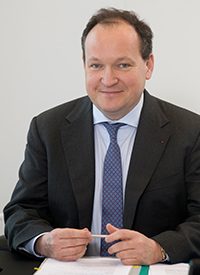View from the Americas: a new frontier for the ‘S’ in ESG
Across the Americas, social-themed financing is evolving to meet the demand of ESG investors in the post-pandemic market.
The official institutions sector can be a catalyst in the sustainable transition by allocating capital and spurring further investments.

From governments and their finance ministries to central banks, public and multilateral development banks, sovereign funds, monetary authorities and market regulators, the public sector, with its diverse roles, has a key role to play in spearheading the world’s sustainable transition, said speakers at the recent BNP Paribas Global Official Institutions Conference 2022 (GOIC).
Laurent Lévêque, Global Head of Official Institutions Coverage, BNP Paribas, opened the event: “In a challenging market context, the official sector has a critical role to play in the sustainable transition, with a growing focus on technology, innovation and collaboration.”

In a challenging market context, the official sector has a critical role to play in the sustainable transition, with a growing focus on technology, innovation and collaboration.
Laurent Lévêque
Global Head of Official Institutions Coverage, BNP Paribas
The European Investment Bank (EIB) finances investment projects currently amounting to circa €60 to 70 billion a year, aligned with priorities of EU member states and with a growing focus on the climate. The EIB has been pioneering sustainable finance since 2007, when it issued the world’s first green bond.
“We have taken a big decision in recent years: to move EIB from being the ‘EU Bank’ to ‘the EU Climate Bank’,” stated Ambroise Fayolle, Vice-President, European Investment Bank (EIB). “Notably, we have a new energy-led policy to phase out financing fossil fuel-based projects.”

We hope that by bringing in other investors in green finance projects this will trigger €1 trillion of investments by 2030. The decade to 2030 is absolutely critical.
Ambroise Fayolle
Vice-President, European Investment Bank (EIB)
The EIB wants climate project financing to reach 50% of its activity by 2025 – and spur a virtuous circle of climate action investments. “We hope that by bringing in other investors in green finance projects this will trigger €1 trillion of investments by 2030,” says Fayolle. “The decade to 2030 is absolutely critical.”
Beyond mitigation projects, often comprising efforts to reduce greenhouse gas emissions, at COP26 last year the EIB announced its decision to triple its commitments to adaptation initiatives by 2025. In the context of growing concerns over energy security, it also aims to speed up investments in renewable energy and energy efficiency, in and outside Europe.
Recently, the bank financed a renewable energy initiative with ENGIE Energy Access in Benin, Africa, to provide 600,000 people in remote areas with access to cheap and reliable electricity through off-grid solar panels. The project will produce numerous positive economic, social and health outcomes for families and entrepreneurs, as well as new opportunities for women and girls. “A big risk we have ahead is that if we don’t make it a just transition, it will fail,” stressed Fayolle.
The Asian Infrastructure Investment Bank (AIIB) counts several G20 nations as founding members and China as one of the largest shareholders. For its Chief Financial Officer Andrew Cross, the green transition it aims to finance must become a global endeavour.
“Encouraging people to move away from ownership of the transition as specifically regional, and to recognise collective global ownership is what matters,” he said.
Cross thinks another key ingredient for success is time, highlighting a sense of ‘urgent patience’ in Asia: “There is an urgency to get things done, but the patience to know that some of these things are fundamentally important and will take a while.”
Cross further underlines a shift over time: “The first green bond I worked on was in 2008-09 at US$200 million. Investors were reluctant, asking for a green premium and expressing concerns around fiduciary duty. Now green bonds have taken off and we have every shade of bond possible.”
As Singapore’s central bank and integrated financial regulator, the Monetary Authority of Singapore (MAS) works with financial institutions to strengthen the resilience of the financial sector against environmental risks. Carolyn Neo, Chief Representative of MAS London Office explains: “as the developer of Singapore as an international financial centre, we are also building a vibrant sustainable finance ecosystem to support Asia’s transition to a low carbon future”.

As the developer of Singapore as an international financial centre, we are also building a vibrant sustainable finance ecosystem to support Asia’s transition to a low carbon future.
Carolyn Neo
Chief Representative, MAS London Office
As part of its comprehensive Green Finance Action Plan to scale sustainable finance in Asia, MAS enhances firms’ access to green or sustainability-linked loans and sustainable bonds, through grants that defray the cost of external reviews for such issuances. MAS also helps to mobilise sustainable infrastructure investments in Asia by catalysing innovative blended finance solutions through public private partnerships, and supports industry efforts to build a voluntary carbon credit market, with an initial focus on nature-based solutions in Southeast Asia.
“To address data challenges collectively at the industry level, MAS is harnessing fintech innovations”, explains Carolyn. “We have launched Project Greenprint, which will collectively aggregate new and existing ESG data from the ground-up, across multiple sectoral systems, and enable the sharing of the data with different parties in a trusted manner”. This includes inter-operable data platforms such as ESG Disclosure Portal and ESG Registry.
To strengthen the resilience of financial system, MAS has also conducted thematic reviews of financial institutions’ progress with its Guidelines on Environmental Risk Management, and published information papers to share good practice and areas for improvement. “By end 2022, we will also conduct industry-wide stress tests on the financial sector incorporating a range of long-term climate scenarios”, adds Carolyn.
Chile is a country with a strong commitment to the transition to a cleaner economy, with the government issuing about US$33 billion of ESG labelled bonds – a mix of green bonds, social bonds, sustainable bonds and recently, sustainability-linked bonds (SLBs).
“In Chile, we have an important story around renewables,” explained Patricio Sepulveda, Head of Public Credit at Chile’s Ministry of Finance. “In 2014, for example, the share of non-conventional or renewable energy was only at 9%. In 2021, we were at about 30%. The increase has been very impressive. Due to our geographical situation, we are the country with one the most powerful solar energy potential. We have the capacity to increase this, in our estimation, to about 80% in the next 10 years.”
In 2019, Chile issued US$2 billion in green bonds with marketing efforts focused on Europe, as well as the US. The country also updated its framework for social and sustainable bonds, and in 2022, and became the first sovereign to issue a sustainability-linked bond with two KPIs geared towards reducing emissions and increasing Chile’s use of renewable energy.
Sepulveda also underlined the growing role of finance in driving the transition: “The Ministry of Finance is now involved in decisions relating to the transition. We’ve shifted mindset and seen our mandate broaden from focusing mainly on the economy and fiscal matters to thinking more holistically about sustainable growth.”
Leading the way in SSA sustainable finance
BNP Paribas has a strong track record in supporting sovereigns, supranationals and international agencies (SSAs) raise capital for projects that support the sustainable transition.
“ESG issuance in the SSA market is accelerating after several quiet months due to market volatility. We expect to see more inaugural ESG sovereign frameworks and bonds launched before the end of 2022, as well as new funding from repeat issuers,” says Jamie Stirling, Global Head of Sovereigns, Supranationals and Agencies Debt Capital Markets at BNP Paribas.
Recent transactions launched in September include:
Across the Americas, social-themed financing is evolving to meet the demand of ESG investors in the post-pandemic market.
Adaptation, implementation and collaboration: three themes that will be front and centre of the COP27 agenda says Ambassador Wael Aboulmagd.